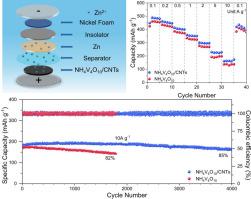Intercalated CNT networks enable high-kinetic NH4V4O10 cathodes with long-term stability in aqueous zinc-ion batteries
IF 5.4
3区 化学
Q1 CHEMISTRY, INORGANIC & NUCLEAR
引用次数: 0
Abstract
Aqueous zinc-ion batteries (AZIBs) represent a promising technology for large-scale energy storage due to their inherent safety, low cost, and environmental benefits. However, cathode dissolution and limited conductivity hinder their practical deployment. To address these challenges, this study successfully synthesized a composite cathode material consisting of NH4V4O10 nanosheets integrated with carbon nanotubes (CNTs) – denoted as NH4V4O10/CNTs – via a hydrothermal synthesis technique. Physical characterization revealed the uniform distribution of CNTs within the NH4V4O10 interlayers, establishing a three-dimensional conductive framework that significantly enhances electron transport. Electrochemical evaluation demonstrated that the composite delivered a specific discharge capacity of 489.1 mAh g−1 at 0.1 A g−1. After subsequent cycling at higher rates and returning to 0.1 A g−1, the capacity recovered to 435.3 mAh g−1. The composite's rate capability substantially outperformed its pure-phase counterparts. Furthermore, at a high current density of 10 A g−1, the composite maintained 85% of its capacity (157.5 mAh g−1) after 4000 cycles. Kinetic analysis indicated a dominant pseudocapacitive contribution of 79.3% at a scan rate of 1.0 mV s−1. These results collectively demonstrate that the NH4V4O10/CNTs composite exhibits both rapid charge/discharge kinetics and long-term cycling stability, offering a viable approach for developing high-performance cathodes in AZIBs.

插层碳纳米管网络使高动力学NH4V4O10阴极在水锌离子电池中具有长期稳定性
水锌离子电池(azib)由于其固有的安全性、低成本和环境效益,是一种很有前途的大规模储能技术。然而,阴极溶解和有限的导电性阻碍了它们的实际应用。为了解决这些挑战,本研究通过水热合成技术成功地合成了一种由NH4V4O10纳米片与碳纳米管(CNTs)集成组成的复合正极材料(标记为NH4V4O10/CNTs)。物理表征揭示了NH4V4O10中间层内碳纳米管的均匀分布,建立了一个三维导电框架,显著增强了电子传递。电化学评价表明,该复合材料在0.1 a g−1下的比放电容量为489.1 mAh g−1。随后以更高的速率循环并返回到0.1 A g−1后,容量恢复到435.3 mAh g−1。该复合材料的速率能力大大优于纯相的同类材料。此外,在10 a g−1的高电流密度下,复合材料在4000次循环后保持了85%的容量(157.5 mAh g−1)。动力学分析表明,在扫描速率为1.0 mV s−1时,假电容占主导地位,贡献79.3%。这些结果共同表明,NH4V4O10/CNTs复合材料具有快速充放电动力学和长期循环稳定性,为开发高性能azib阴极提供了可行的方法。
本文章由计算机程序翻译,如有差异,请以英文原文为准。
求助全文
约1分钟内获得全文
求助全文
来源期刊

Inorganic Chemistry Communications
化学-无机化学与核化学
CiteScore
5.50
自引率
7.90%
发文量
1013
审稿时长
53 days
期刊介绍:
Launched in January 1998, Inorganic Chemistry Communications is an international journal dedicated to the rapid publication of short communications in the major areas of inorganic, organometallic and supramolecular chemistry. Topics include synthetic and reaction chemistry, kinetics and mechanisms of reactions, bioinorganic chemistry, photochemistry and the use of metal and organometallic compounds in stoichiometric and catalytic synthesis or organic compounds.
 求助内容:
求助内容: 应助结果提醒方式:
应助结果提醒方式:


